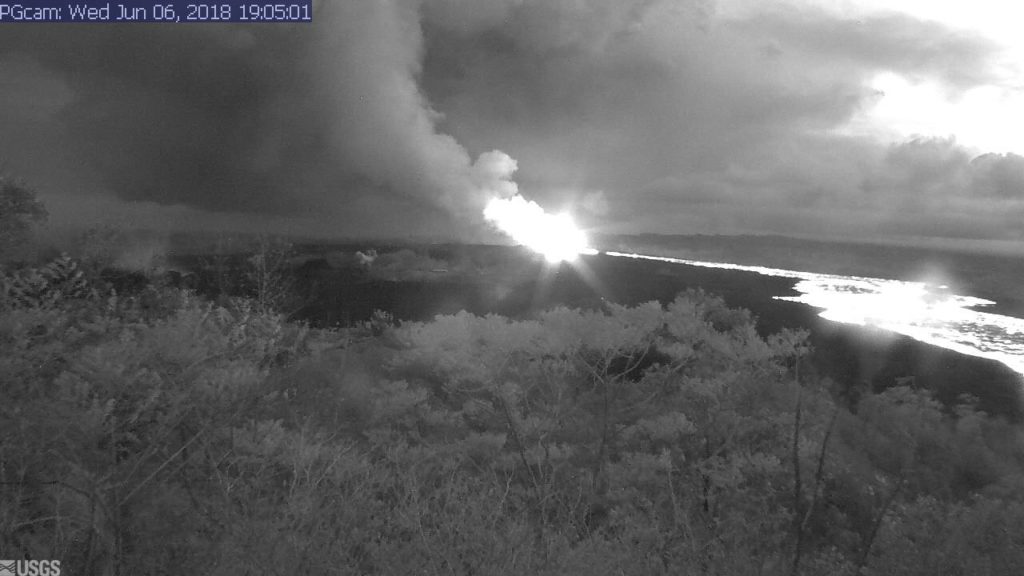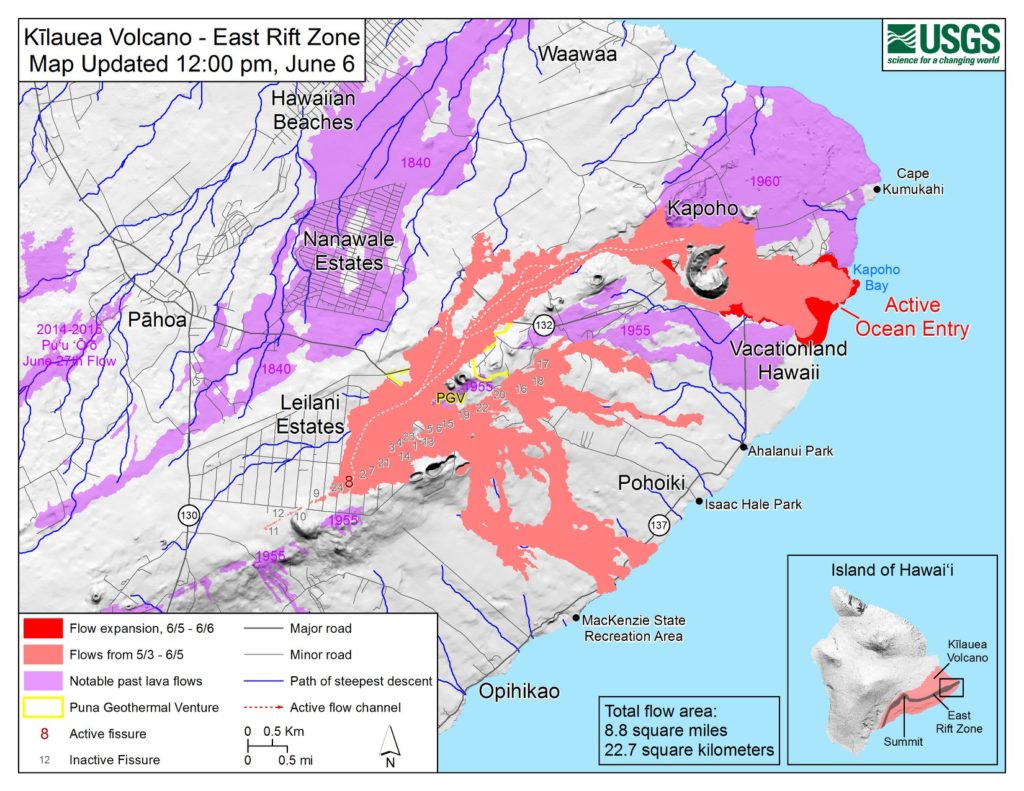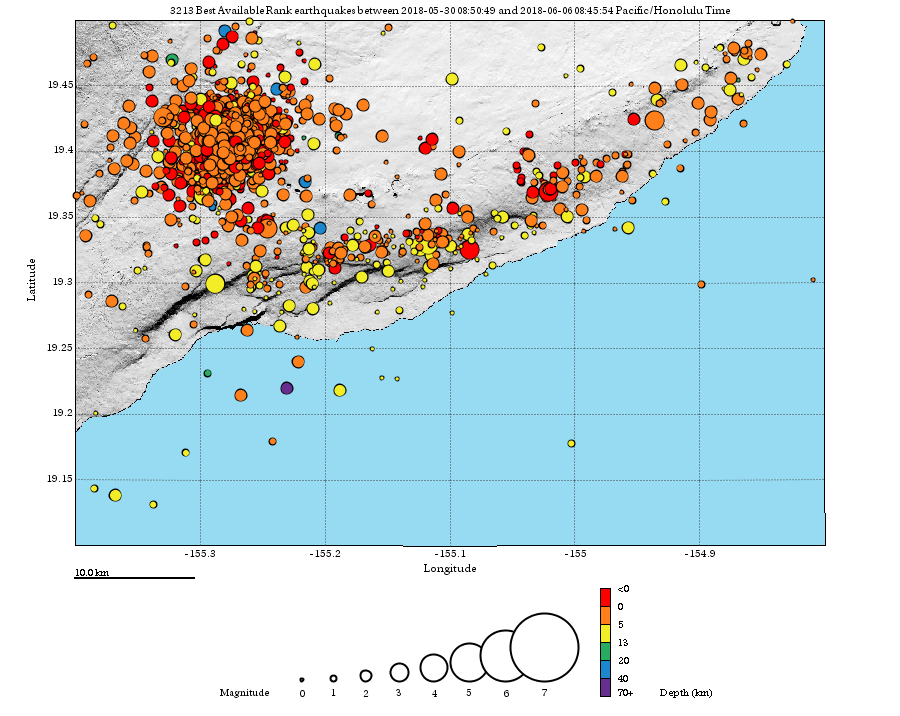10:30 PM: Magma Continues

Fissure 8: two lava fountains, two cinder cones, one rainbow, one gas plume (with lots of sulfur dioxide) rising and drifting downwind. Lava flows in the foreground were produced by flows issuing from this fissure. Volcanic gas and heat stripped the trees of their leaves and singed the branches when the wind shifted direction prior to this photograph being taken on June 5, 2018. Photo from the (new) southern end of Nohea Street in Leilani Estates subdivision, Pāhoa. Downed power lines can be seen in the lower right of the photo. PC: USGS
This news story will be updated throughout the day as new information becomes available and new articles will be added to the website’s “News” section. Previous information about ongoing events can be found in Big Island Now’s “Volcano Blog” section.
LIVESTREAM VIDEO Kīlauea Volcano Summit Live Stream (below) from the USGS Hawaiian Volcano Observatory observation tower viewed toward the east-southeast. VC USGS
Wednesday, June 6, 2018, 10:30 p.m.
Vigorous eruption of lava continues from the lower East Rift Zone (LERZ) fissure system in the area of Leilani Estates.
Lava fountaining at Fissure 8 continues, with fountain tops reaching heights of 130-210 feet, This activity is feeding a lava channel flowing east to the Kapoho Bay area. Lava is continuing to enter the ocean in the area of the Vacationland subdivision. A late afternoon overflight showed that the ocean entry is creating a vigorous steam plume that is being blown inland to the southwest. The delta that formed at Kapoho Bay extended slightly throughout the day, and a lateral lobe of the flow is pushing slowly north through what remains of the Kapaho Beach Lots subdivision..
The northern lobe of the Fissure 8 flow appears to have stalled with only traces of smoke at the flow front, although there is some incandescence in the finger of that lobe that advanced along a low graben a few nights ago. No other fissures are active.
Pele’s hair and other lightweight volcanic glass from high fountaining of Fissure 8 are falling downwind of the fissure and accumulating on the ground within Leilani Estates. Winds may waft lighter particles to greater distances. Residents are urged to minimize exposure to these volcanic particles, which can cause skin and eye irritation similar to volcanic ash.
The ocean entry is a hazardous area. Hazards include walking on uneven, glassy lava flow surfaces and around unstable, vertical sea cliffs. Venturing too close to an ocean entry on land or the ocean exposes you to flying debris from sudden explosive interaction between lava and water. Also, the lava delta is unstable because it is built on unconsolidated lava fragments and sand. This loose material can easily be eroded away by surf, causing the new land to become unsupported and slide into the sea. In several instances, such collapses have also incorporated parts of the older sea cliff. Additionally, the interaction of lava with the ocean creates “laze”, a corrosive seawater plume laden with hydrochloric acid and fine volcanic particles that can irritate the skin, eyes, and lungs.
Magma continues to be supplied to the lower East Rift Zone. Earthquake locations have not moved farther downrift in the past few days and the number of located earthquakes remains low. Seismicity remains relatively low with numerous small magnitude earthquakes and low amplitude background tremor.
Wednesday, June 6, 2018, 7 p.m.
Hawaiian Volcano Observatory reports an eruption at 4:10 this evening at the Kīlauea Summit resulting in a 10,000 foot high ash plume. The National Weather Service is reporting slow, easterly winds over the next two days. Volcanic gas output and ash emissions may affect air quality across the central and southern half of the island.
Due to the changing wind conditions, the following is provided for your awareness:
- Take action to limit further exposure.
- Ash fallout may cause poor driving conditions. Drive with extreme caution, or pull over and park.
- A community meeting on volcanic ash and VOG will be held at 7 p.m.,Thursday June 7, in Volcano at the Cooper Center.
- You can monitor volcanic gas levels on Hawai‘i Island by visiting the Civil Defense website or go directly to www.epa.gov/kilaueaairdata.
Hawaiian Volcano Observatory reports vigorous lava eruptions continue in the lower East Rift Zone. The Fissure 8 flow has filled Kapoho Bay and is extending .7 miles from shore.
Due to the current volcanic activity, the following policies are in effect:
- Government Beach Road, between Kahakai Boulevard and Cinder Road, is open to Wa‘a Wa‘a and Papaya Farms Road residents only with official credentials. There is no curfew.
- Residents in this area should heed warnings from Civil Defense officials and be prepared to evacuate with little notice.
The Kea‘au Armory shelter has reached capacity. If you need shelter, the covered court at Pāhoa Community Center is open and pet-friendly.
Unmanned Aircraft Systems (UAS) conducted a mission on Kīlauea Volcano’s lower East Rift Zone to collect video of flowing lava in the upper lava channel of fissure 8.
Scientists use the video to assess lava flow velocities, which are measured by tracking surface features in the stationary video view. Using UAS for this type of investigation has many advantages because the aircraft can hover above hazardous areas and it utilizes stabilized gimbals and mounts so that the video captured by onboard HD cameras is steady and smooth. Information obtained from this mission was relayed to Hawai‘i County emergency officials to aid in issuing emergency alerts and notices about the timing of evacuations. Video by the U.S. Geological Survey and Office of Aviation Services, Department of the Interior, with support from the Hawaiian Volcano Observatory.
HVO’s mid-day overflight on June 5 shows ongoing partial collapse of Halema‘uma‘u at the summit of Kīlauea Volcano.
To the north of the former visitor Overlook parking area (closed in 2008) is the site of the former lava lake—now a deep hole piled with wall-rock rubble. The western portion of Halema‘uma‘u has moved down and toward the center of the crater as new cracks form on the caldera floor to the west. Kīlauea’s summit continues to subside due to withdrawal of magma towards the volcano’s East Rift Zone.
Wednesday, June 6, 2018, 4:30 p.m.
The Pacific Tsunami Warning Center reports the earthquake that occurred at approximately 4:10 p.m. was NOT large enough to cause a tsunami for the Island of Hawai‘i. There is NO tsunami threat for the island of Hawai‘i.
Preliminary data indicates that the earthquake measuring a magnitude of 5.6 was centered at the Kīlauea Summit.
As in all earthquakes, be aware of the possibility of aftershocks. If the earthquake was strongly felt in your area, precautionary checks should be made for any damages; especially to utility connections of gas, water and electricity.
ADDITIONAL INFORMATION: An ash plume has been detected traveling to the southwest. Avoid ash by staying indoors.
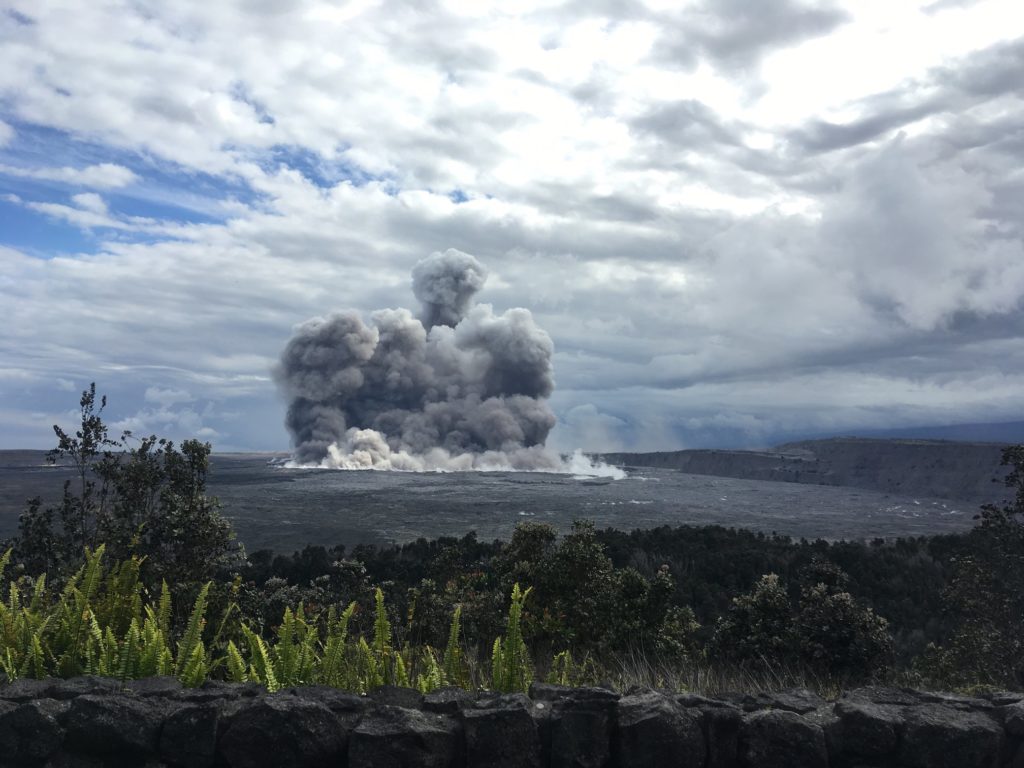
Explosive eruption at Kīlauea summit, equivalent to energy release of M5.6 (preliminary), occurred at 4:07 PM HST. Ash plume reached 10,000 ft above sea level. Downwind communities may experience ashfall.
Hawaiian Volcano Observatory reports that an ash eruption at the Kīlauea Summit occurred at about 4:10 PM. The resulting ash plume reached 10,000 feet high and may affect the surrounding areas. The wind is blowing in the southwest direction and ash fallout may affect the areas of Volcano and Pahala. Please be on the alert.
Due to the volcanic activity, the following is provided for your awareness:
- If you are at home, stay indoors with the windows closed. If you are outside, seek cover.
- If you are in the car, keep the windows closed. Ash fallout may cause poor driving conditions. Drive with extreme caution, or pull over and park.
- After the hazard has passed, do check your home, and especially your catchment system for any impact that may affect your water quality.
Again, the Pacific Tsunami Warning Center reports the earthquake that occurred at approximately 4:10 p.m. was NOT large enough to cause a tsunami for the island of Hawai‘i. NO tsunami threat.
If any additional information becomes available, you will be notified.
Wednesday, June 6, 2018, 4 p.m.
Vigorous eruption of lava continues from the lower East Rift Zone (LERZ) fissure system in the area of Leilani Estates.
This morning, lava fountaining at Fissure 8 continued to reach heights of 150-180 feet, feeding a stable channel to the east to the ocean entry in the Kapoho Bay area. Lava is entering the ocean in the Vacationland subdivision. Vacationland has been completely covered by lava, and overnight the flow expanded north by 100 m within Kapoho Beach Lots. The lava delta that formed at Kapoho Bay extended slightly overnight.
The northern lobe of the Fissure 8 flow shows no signs of activity this morning, and there is only wispy smoke at the flow front. No other fissures are active.
Pele’s hair and other lightweight volcanic glass from high fountaining of Fissure 8 are falling downwind of the fissure and accumulating on the ground within Leilani Estates. Winds may waft lighter particles to greater distances. Residents are urged to minimize exposure to these volcanic particles, which can cause skin and eye irritation similar to volcanic ash.
The ocean entry is a hazardous area. Hazards include walking on uneven, glassy lava flow surfaces and around unstable, vertical sea cliffs. Venturing too close to an ocean entry on land or the ocean exposes you to flying debris from sudden explosive interaction between lava and water. Also, the lava delta is unstable because it is built on unconsolidated lava fragments and sand. This loose material can easily be eroded away by surf, causing the new land to become unsupported and slide into the sea. In several instances, such collapses have also incorporated parts of the older sea cliff. Additionally, the interaction of lava with the ocean creates “laze”, a corrosive seawater plume laden with hydrochloric acid and fine volcanic particles that can irritate the skin, eyes, and lungs.
Magma continues to be supplied to the lower East Rift Zone. Earthquake locations have not moved farther downrift in the past few days and the number of located earthquakes remains low. Seismicity remains relatively low with numerous small magnitude earthquakes and low amplitude background tremor.
Kīlauea Volcano Summit
Earthquake activity is increasing after Tuesday morning’s small explosion, with ten M3+ earthquakes since 5 am in the Kīlauea summit area. This pattern suggests that more felt earthquakes and a small explosion are likely within the next few hours. Monitoring data indicate that subsidence at the summit and inward slumping of the rim and walls of Halema`uma`u continues.
Over the last week, sulfur dioxide emissions from the volcano’s summit have decreased, but emission rates remain high enough to impact air quality in downwind regions. Additional bursts of gas released with intermittent explosive activity are also transported downwind and may temporarily affect air quality as well.
Wednesday, June 6, 2018, 1:30 p.m.
Map as of noon June 6, 2018. Given the dynamic nature of Kīlauea’s lower East Rift Zone eruption, with changing vent locations, fissures starting and stopping, and varying rates of lava effusion, map details shown here are accurate as of the date/time noted.
The National Weather Service reports slow, easterly winds are expected to bring vog to the island interior starting tonight, and over the next two days. Volcanic gas output and ash emissions may increase, affecting air quality across the central and southern half of the island. The trades are expected to pick up again by the weekend.
Due to the changing wind conditions, the following is provided for your information:
- Take action to limit further exposure.
- A community meeting on volcanic ash and VOG will be held at 5:30 this evening, in Kona at the West Hawai‘i Civil Center Council Chambers – Building A.
- You can monitor volcanic gas levels on Hawaii Island by visiting the Civil Defense website or go directly to www.epa.gov/kilaueaairdata.
Hawaiian Volcano Observatory reports vigorous lava eruptions continue in the lower East Rift Zone. Vacationland is completely covered by lava and a large laze plume is rising from the ocean entry in that area. The Fissure 8 flow has filled Kapoho Bay and is extending .7 miles from shore.
Due to the current volcanic activity, the following policies are in effect:
- Residents are advised to stay away from all areas of volcanic activity.
- Government Beach Road, between Kahakai Boulevard and Cinder Road, is open to Wa‘a Wa‘a and Papaya Farms Road residents only with official credentials. There is no curfew.
- Residents in this area should heed warnings from Civil Defense officials and be prepared to evacuate with little notice.
The Kea‘au Armory shelter has reached capacity. If you need shelter, the covered court at Pāhoa Community Center is open and pet-friendly.
NOON: VIDEO UPDATE: Fissure 8 lava channel
VIDEO ABOVE: Unmanned Aircraft Systems (UAS) conducted a mission on Kīlauea Volcano’s Lower East Rift Zone to collect video of flowing lava in the upper lava channel of Fissure 8. Scientists use the video to assess lava flow velocities, which are measured by tracking surface features in the stationary video view. Using UAS for this type of investigation has many advantages because the aircraft can hover above hazardous areas and it utilizes stabilized gimbals and mounts so that the video captured by onboard HD cameras is steady and smooth. Information obtained from this mission was relayed to Hawai‘i County emergency officials to aid in issuing emergency alerts and notices about the timing of evacuations. Video by the U.S. Geological Survey and Office of Aviation Services, Department of the Interior, with support from the Hawaiian Volcano Observatory.

High-resolution radar data from the German TerraSAR-X satellite acquired on June 2 (left) and from the Canadian RADARSAT-2 satellite on June 4 (right) show the area of the Fissure 8 lava flow, which appears as a darkened area in both images.
LEFT: The International Charter for Space and Major Disasters is a means for space agencies around the world to help with disaster monitoring by providing satellite data to responders and scientists on the ground.
The charter was invoked for recent eruptive activity at Kīlauea and numerous space agencies are providing satellite imagery that HVO scientists are using to help evaluate eruptive activity.
11 a.m.: USGS MEDIA UPDATE AUDIO FILE FROM June 5
10:39 a.m.: NO TSUNAMI THREAT from 4.1M quake
The Pacific Tsunami Warning Center reports the earthquake that occurred at approximately 10:39 a.m. was NOT large enough to cause a tsunami for the Island of Hawai‘i.
There is NO tsunami threat for the island of Hawai‘i.
Preliminary data indicates that the earthquake measuring a magnitude of 4.1 was centered at the Hāmākua Coast.
As in all earthquakes, be aware of the possibility of aftershocks. If the earthquake was strongly felt in your area, precautionary checks should be made for any damages; especially to utility connections of gas, water and electricity.
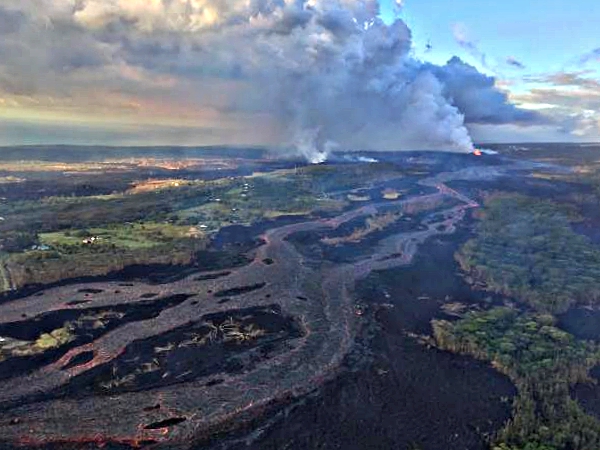
Robust Fissure 8 lava channels and ocean entry plume.This view, looking south at Kīlauea’s Lower East Rift Zone, was captured during HVO’s 6 a.m. helicopter overflight on June 6, 2018. It shows continued fountaining of Fissure 8 and the lava flow channel fed by it. Lava continues to flow quickly in these braided channels; the flow margins are currently stable and have not experienced any breakouts since June 5.
8:35 a.m., USGS VIDEO UPDATE: Ongoing partial collapse of Halema‘uma‘u Crater
https://www.facebook.com/USGSVolcanoes/videos/2055034881191729/?t=54
The mid-day overflight of Kīlauea Volcano’s summit on June 5, 2018, shows ongoing partial collapse of Halema‘uma‘u Crater in Hawai’i Volcanoes National Park. To the north of the old Overlook parking area (closed in 2008) is the site of the former lava lake—now a deep hole piled with wall-rock rubble. The western portion of Halema‘uma‘u has moved down and toward the center of the crater as new cracks form on the caldera floor to the west. The summit is still subsiding due to withdrawal of magma towards the East Rift Zone.
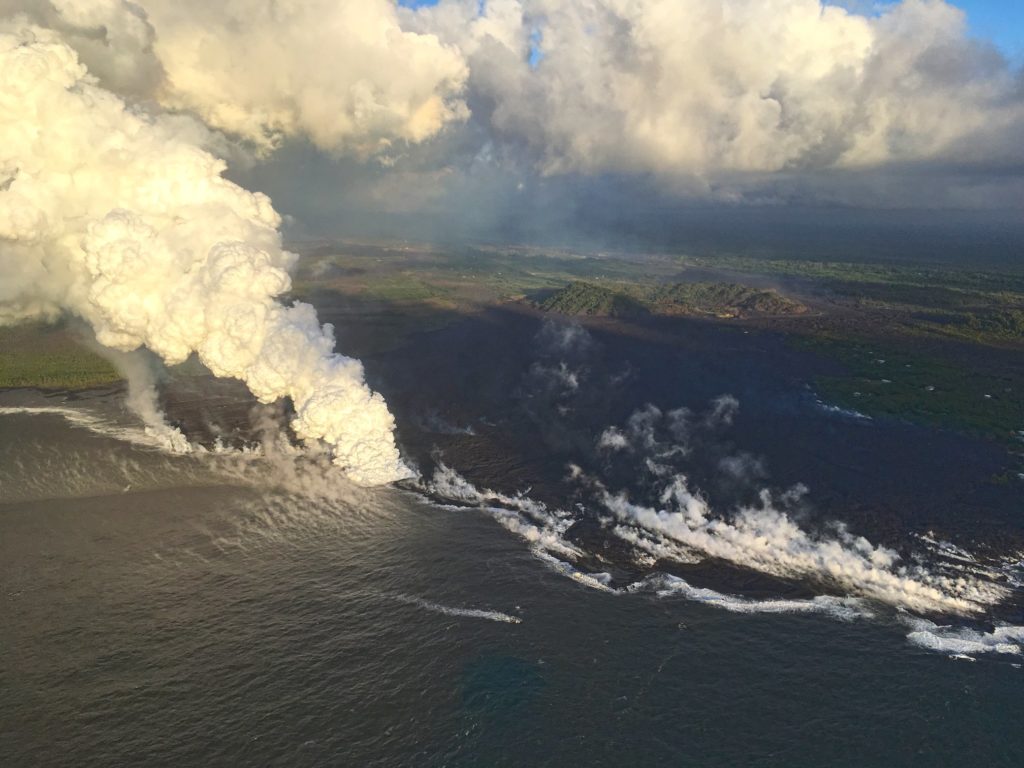
Kīlauea eruption, Wednesday, June 6, 2018 6:30 a.m. This USGS overflight confirms the Vacationland area is completely covered. Flows extended 100 yards north in Kapoho Beach Lots. Lava continues to enter ocean at Vacationland. Fissure 8 fountaining remains strong. PC: USGS
6 a.m. VOLCANIC GAS EMISSIONS remain very high
Hawaiian Volcano Observatory reports that vigorous lava eruptions continue in the lower East Rift Zone.
Fissure 8 is very active and producing a large channelized flow that has filled in Kapoho Bay.
The ocean entry is sending a large laze plume into the air along the coastline.
Due to the lava entering the ocean, the following policies are in effect:
- Laze is formed when hot lava hits the ocean sending hydrochloric acid and steam with tiny glass particles into the air.
- Be aware of the laze hazard and stay away from any ocean plume.
- Health hazards of laze include lung damage, and eye and skin irritation.
- Be aware that the laze plume travels with the wind and can change direction without warning.
Due to the current volcanic activity, the following policies are in effect:
- Government Beach Road, between Kahakai Boulevard and Cinder Road, is open to Waa Waa and Papaya Farms Road residents only with official credentials. There is no curfew.
- Residents in this area should heed warnings from Civil Defense officials and be prepared to evacuate with little notice.
- The shelter at Pāhoa Community Center is open and pet-friendly.
- The Kea‘au Armory shelter has reached capacity.
Hawaiian Volcano Observatory reports volcanic gas emissions remain very high from fissure eruptions.
Due to the elevated gas levels, the following is provided for your information:
A community meeting on volcanic ash and VOG will be held today, Wednesday, June 6, in Kona at the West Hawaii Civil Center Council Chambers – Building A, at 5:30 in the evening.
Monitor sulfur dioxide and hydrogen sulfide on Hawai‘i Island by visiting the Civil Defense website or go directly to www.epa.gov/kilaueaairdata.
Tuesday, June 5, 10:28 p.m.: HAWAIIAN VOLCANO OBSERVATORY STATUS REPORT
Kīlauea Volcano Lower East Rift Zone
Vigorous eruption of lava continues from the lower East Rift Zone (LERZ) fissure system in the area of Leilani Estates and Lanipuna Gardens.
Persistent lava fountaining at Fissure 8 is reaching heights of 150-180 feet. This eruptive activity continues to feed a channel transporting lava to the east to the ocean entry in the Kapoho Bay area. Minor breakouts along the channelized flow have been very small and stagnated before travelling any significant distance. HVO’s late afternoon overflight showed that the Fissure 8 flow is continuing to form a lava delta with limited continuing advances into the surviving parts of the Kaphoho Beach Lots and Vacationlands neighborhoods. The northernmost lobe of the Fissure 8 flow is advancing very slowly to the northeast. No other fissure vents are active.
Pele’s hair and other lightweight volcanic glass from high fountaining of Fissure 8 are falling downwind of the fissure and accumulating on the ground within Leilani Estates. Winds may waft lighter particles to greater distances. Residents are urged to minimize exposure to these volcanic particles, which can cause skin and eye irritation similar to volcanic ash.
HVO field crews are on site tracking the fountains, lava flows, and spattering from multiple fissures as conditions allow and are reporting information to Hawaii County Civil Defense.
Volcanic gas emissions remain very high from the fissure eruptions. Trade wind conditions are bringing vog to the south and west sides of the Island of Hawaii. Afternoon easterly winds may bring vog to communities in the Volcano area.
The ocean entry is a hazardous area. Hazards include walking on uneven, glassy lava flow surfaces and around unstable, vertical sea cliffs. Venturing too close to an ocean entry on land or the ocean exposes you to flying debris from sudden explosive interaction between lava and water. Also, the lava delta is unstable because it is built on unconsolidated lava fragments and sand. This loose material can easily be eroded away by surf, causing the new land to become unsupported and slide into the sea. In several instances, such collapses have also incorporated parts of the older sea cliff. Additionally, the interaction of lava with the ocean creates “laze”, a corrosive seawater plume laden with hydrochloric acid and fine volcanic particles that can irritate the skin, eyes, and lungs.
Magma continues to be supplied to the lower East Rift Zone. Earthquake locations have not moved farther downrift in the past few days and the number of located earthquakes remains low. Seismicity remains relatively low with numerous small magnitude earthquakes and low amplitude background tremor.
Additional ground cracking and outbreaks of lava in the area of the active fissures are possible. Residents downslope of the region of fissures should heed all Hawaii County Civil Defense messages and warnings.
USGS/HVO continues to monitor the lower East Rift Zone activity 24/7 in coordination with Hawaii County Civil Defense.
Kīlauea Volcano Summit
Earthquake activity dropped after Tuesday morning’s small explosion but is slowly rising now, following the pattern of previous events of this type. Monitoring data indicate that subsidence at the summit continues. The mid-day observation flight showed additional Inward slumping of the rim and walls of Halema`uma`u.
Locally felt earthquakes are expected to continue, and further ash explosions are likely.
Over the last week, sulfur dioxide emissions from the volcano’s summit have decreased, but emission rates remain high enough to impact air quality in downwind regions. Additional bursts of gas released with intermittent explosive activity are also transported downwind and may temporarily affect air quality as well.
For forecasts of where ash would fall under forecast wind conditions, please consult the Ash3D model output here: https://volcanoes.usgs.gov/observatories/hvo/activity_2018.html
Information on volcanic ash hazards and how to prepare for ash fall maybe found at http://www.ivhhn.org/information#ash (health impacts) OR https://volcanoes.usgs.gov/volcanic_ash/ (other impacts).



